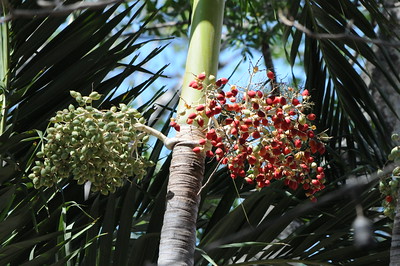
Butia: pindo
Also known as jelly palm.
Pindo palm belongs to the subfamily of Arecoideae. It's in the Cocoseae tribe, and Butinae subtribe. Temperate climate palm.


Fruits from the family of true palms are known for their health benefits.
Arecaceae is the official scientific family name of true palms. Palmae is a synonym for this family.
Many fruits of the palm family have phytoprogestins and smaller amounts of phytoestrogens. There's a lack of information on lignan content on many palm tree fruits.
Palm fruits generally contain sterols, which are phytoprogestins. Common sterols in palm fruits are: stigmasterol, betasitosterol and campesterol.
Many contain flavonoids which are phytoestrogens.
These fruits contain fatty acids, primarily: oleic acid and palmitic acid.
About fruits from some commonly known palms. Subfamilies of palm trees: Arecoideae, Ceroxyloideae, Coryphoideae, Calamoideae and Nypoideae.
Palms can also be categorized by leaf or prond shape: palmate, pinnate and costapalmate. Pinnate leaves are feather shaped. Palmate leaves have a fan shape. Costapalmate leaves are a combination of the two shapes. Some palms with pinnate leaves are smooth at the leaf base, because they are self-cleaning. This leaf base on smooth pinnate palms is known as a crownshaft.
For geographical convenience, basic climate regions are included.
This subfamily of palms are pinnates. Arecoideae contains tropical and subtropical palms.

Also known as jelly palm.
Pindo palm belongs to the subfamily of Arecoideae. It's in the Cocoseae tribe, and Butinae subtribe. Temperate climate palm.

In these programs, coconut oil works well as a substitute for saw palmetto. The same is expected of unprocessed coconut fruit.
Coconut belongs to the palm subfamily of Arecoideae. It's in the Cocoseae tribe, and Butinae subtribe. Tropical palm.
This fruit's seed looks like a small coconut on the inside of the yellow exterior. These edible seeds are called coquitos.
Wine palm belongs to the palm subfamily of Arecoideae. It's in the Cocoseae tribe, and Butinae subtribe. Temperate, cold hardy palm.
Contains varying leaf types. This subfamily of palms are from tropical regions.

Aguaje, also known as buriti, is a fruit from the palm tree of Mauritia flexuosa. Buriti has a reputation for use for causing butt growth.
Mauritia contains phytoprogestins: stigmasterol, betasitosterol and campesterol. It also contains flavonoids which are phytoestrogens.
Mauritia's anti-inflamatory actions suggest it may contain lignans that upregulate the effects of estrogens on ER-beta, and that can upregulate the effects of androgens. However, there's nothing available on lignan content on aguaje. There's uncertainty about the ratio of potencies of these phytohormones in buriti.
As for nonsteroidal components, aguaje contains fatty acids, primarily: oleic acid and palmitic acid.
Mauritia belongs to the palm subfamily of Calamoideae. This palm is native to tropical regions of South America.
Mauritiella and Lepiocaryum are two other genus of palms that resemble Mauritia and are from the same subfamily. These palms are from tropical regions of the same continent as well. Mauritiella, like Mauritia, also goes by buriti. Lepiocaryum is also called poktamui.
Snake fruit comes from this palm.
Salacca belongs to the subfamily of Calamoideae. Other genus in this subfamily are climbing palms. Tropical palm from Southeast Asia.
The genus of Raphia can be found in America, Africa and Madagascar, so it's uncertain if this plant was introduced by people to different regions.
These three genus of palm resemble each other and are from tropical regions of Africa. They belong to the subfamily of Calamoideae.
Contains pinnate leaves. Subfamily of palms from tropical regions, mostly from Americas.
Palmate, fan shaped, palms with few exceptions.
Sabal palmetto belongs to the subfamily Coryphoideae. Subtropical region palm.

Has a reputation for decreasing androgenic symptoms. Inhibits 5α-deductase activity. Other palm fruits may have similar effects.
Saw palmetto works consistently well in herb programs.
Serenoa belongs to the subfamily Coryphoideae. Is a shrub palm. Subtropical region palm.
Palms of the Phoenix genus belong to the subfamily of Coryphoideae. It's a pinnate palm, unlike most others of this family. Subtropical palm.
Nypa fruticans is the only species in the subfamily of Nypoideae. It's the only brackish water palm. It has pinnate leaves.
The edible seed of Nypa has flesh that is like that of a coconut.
Tropical palm native to southeast Asia along the Pacific and Indian Oceans. This palm may be invasive in non-native habitats.
Palm trees that can live throughout temperate climates, that are either subtropical or colder regions. Subfamilies of Arecoideae and Coryphoideae contain palm species that can live within these climates.
Arecoideae: Jubaea (Chilean wine palm)
Coryphoideae: Sabal (dwarf palmetto, cabbage palm), Bismarckia nobilis (Bismarck)
Coryphoideae: Trachycarpeae
Sabal is a little more cold-hardy than Serenoa.
Arecoideae: Butia capitata (pindo)
Coryphoideae: Nannorrhops ritciana (Mazari)
Coryphoideae: Trachycarpeae

Saw palmetto and coconut oil can be taken during proliferative and luteal phases. Coconut and saw palmetto contain phytoprogestins, with insignificant amounts of estrogens, and they anecdotally have progestogenic effects as well, so these can be used for proliferative. A minimal amount of saw palmetto and coconut can be taken at the beginning of menses, if there's no swelling or brown spotting. Other palm replacements for saw palmetto and coconut aren't yet established.
Other true palms fruits can be tried before mid luteal phase. Other fruits per genus has to be tested first for efficacy for each of proliferative or luteal. Date palm, for instance, can't be used during proliferative phase, because it appears to have other hormonal properties.
Palm fruits are best used when there's no swelling.
Palmae or herbs with similar properties are in herb programs based on menstrual phases. There must be balance throughout phases, and combinations of herbs help the body acheive balance for health, breast growth and hip growth. It's important that menses is light and short. Also, preventing an excess of negative symptoms for menses helps set the balance for proliferative phase. Luteal phase uses a different combination of herbs than proliferative phase for symptoms. For a simplified herb schedule, where there's commonality of herb recommendations for symptoms such as swelling and signs of excess estrogen, use nonmenses. BCP01 is a composite page of pieces of different programs on birth control or IUD use.
Herb timing and combinations' success for breast enhancement relies on menstrual phases. Descriptions and pictures of results from herb combination use can be seen in programs. For more guidance, see guide, or hirsutism-topic.
Olive oil and powdered wild yam can be used as direct replacements for saw palmetto and coconut oil. Walnut is another substitute, which it may be better to boil first to help remove allergens: this method doesn't work on all foods, and it's better to avoid foods which may cause this concern.
During luteal, more herbs that contain both progestin and estrogenic constituents can likely be used in place of palm fruits and their oils. Possible replacements only during luteal phase include: fenugreek and suma.
Part of the reason that this is here is so substitutes can be made. However, all substitutions have to be tested first. Palm date fruits don't work the same as saw palmetto or coconut oil.

Excess use of fruits and other food products from betel (Areca; betel nut) palm are associated with negative health symptoms.
True palms shouldn't be confused for other plants that have a palm like appearance. Cycad or Sago palm isn't a real palm, and it's poisonous.
See precautions for more details of care to be taken with herb use. Proper nutrition is a consideration for health. Also, check for the latest blog updates about herb and hormone safety.
It is very important that menses be light and not prolonged.
If you have hirsutism, PCOS, hot-flashes, other signs of hormone imbalances, see estrogen-imbalance, and hirsutism program journals at hirusitism-topic before trying herbs.
Herb concentrates can be tens of times more potent by weight than herbs in solid form. This can easily lead to hormone imbalances. For this reason, concentrate extracts are not recommended for extended or excessive internal use, especially during fertility years. Concentrates shouldn't be used to overcome plateaus. Another issue with herbal extracts, is that they may not have the full range of properties of the herb. Essential oils are not recommended for breast enhancement. If opting to use herbal extracts, use food grade extracts, with no more than 1 drop at a time diluted in water.


For the latest herb programs and how to get started, see: guide. Pictures of breast enhancement can be seen in the program journals of Anon02, Anon08, Anon09, Bubblemelon and Jellie.
For resources on hips and butt enhancement, see: /appendix/hips-butt-enhancement and /appendix/kettlebell.
breast-endocrinology.pdf describes the science of breast development and endocrinology. It also describes symptoms related to hormone imbalances. Biology and hormone imbalances are excerpts from this ebook. breast-endocrinology.pdf uses a Creative Commons (CC BY-ND 4.0) license.
References:
Etymology & Definitions: